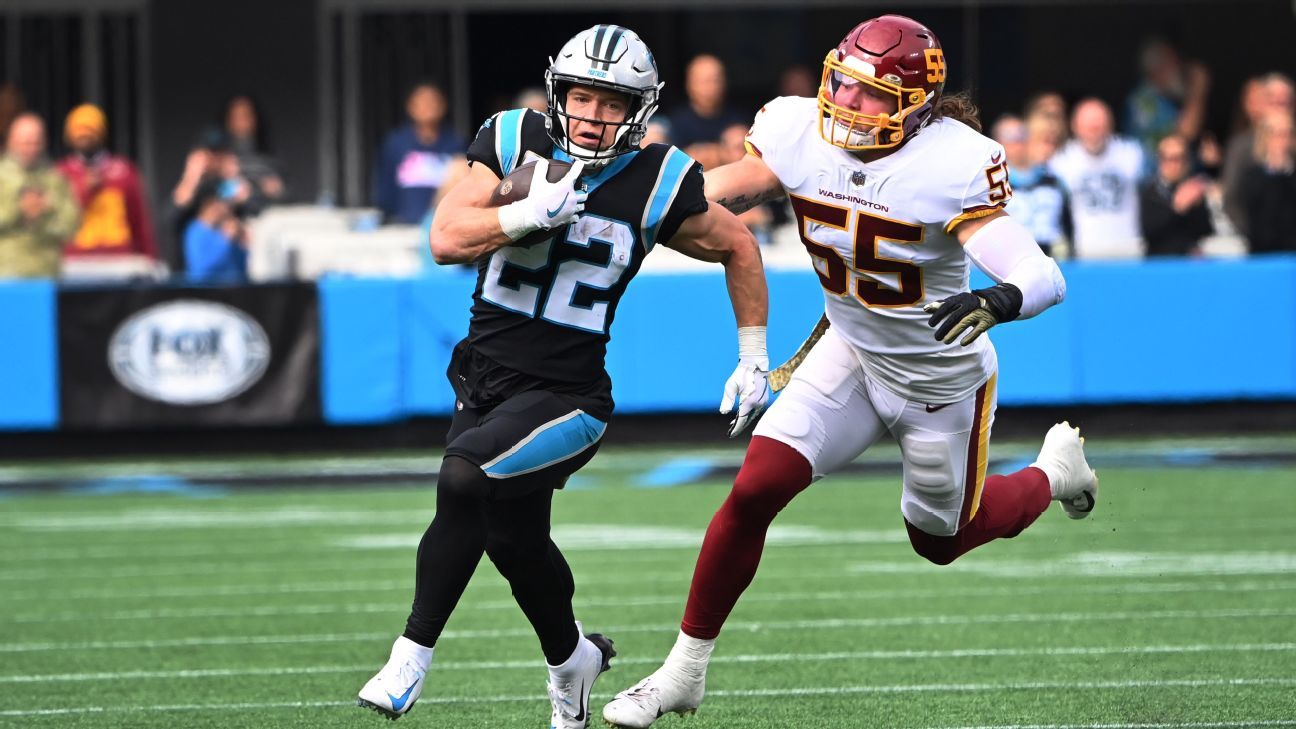An Analytic Approach to Fanbase Rankings.
Interesting read which is more marketing driven than passion driven (KC and Buffalo prime examples)
Data is from the past 20 years which explains a lot (Cheatriots and Rams)
Still a lot of interesting surprises though.
https://www.fandomanalytics.com/post/nfl-fanbase-rankings-2022
2 days ago
12 min read
2022 NFL Fandom Rankings
The Green Bay Packers have a 30-year waiting list for season tickets. Kansas City Chiefs fans celebrate breaking records for the loudest outdoor stadium. For six years, Saturday Night Live ran an ongoing skit about the Chicago Bears’ super-fans. The Dallas Cowboys lead the league in attendance and social media following and even have TV shows about their cheerleaders. So who are really the most loyal and passionate fans in the NFL? And why does the question matter?
The NFL continues to be the king of American sports leagues. COVID hit the league less than other major sports, and the league recovered more quickly. The NFL started from a stronger position than the other leagues in terms of attendance, revenues, and TV ratings.
Also streaming on Apple Podcasts, Spotify, and Stitcher.
The NFL dominates the sports landscape for myriad reasons. The NFL is an “event” driven league, and it is a league built for community. While the NFL has expanded into Mondays and Thursdays, the emphasis on a mainly single day of the week creates a focal point for fans’ attention. It also creates an opportunity for weekly hype shows to lead into the day’s schedule. Football is also built for gambling. Fantasy football has dramatically expanded the NFL fan community as now even your elderly aunt might have a vested interest in Kansas City’s QB or the Packers’ defense.
The NFL also gets credit for masterful marketing as even the off-season is filled with events. The NFL Draft is the prime example as the sports world's attention is fixed on the transfer of talent from the college to the pro game for an entire weekend. But there is also free agency, the combine, and the schedule announcement.
We (The Emory Marketing Analytics Center and Fanalytics Podcast) pay special attention to the NFL because it showcases important lessons about consumer passion (fandom), and we can illustrate the power of analytics for sports and marketing.
The Emory Marketing Analytics Center’s and Fanalytics NFL preview includes two original but related analyses. One analysis is an assessment of the NFL's top brands in terms of fan commitment. The second analysis is a deep dive into NFL quarterbacks. This analysis includes the development of a new QB performance measure and a discussion of the QB narratives with which each team will begin the 2022 season. The second analysis will start in late May or early June.
The analyses are related because the brand loyalty (I call it Fan Equity) analysis is a snapshot of the moment. It’s a look at the strength of fandom as of the end of the 2022 season. Since fandom is created over many seasons or even generations, this is a look into the past. The QB analysis is a look into the future. QBs are the overwhelming key to winning in the NFL, and winning is what ultimately builds fandom.
The fanbase rankings are a critical sports business story. Knowing where the passion lies and will lie in the future is essential for every sports league. Fandom is the driver of current revenues for leagues. But beyond basic questions of which teams to put on TV, the analysis shed light on something fundamental about fandom. Fans choose to be fans because they want to belong to something. Being a Green Bay Packers fan is like being part of a “cool club”. Being a fan of the Washington NFL franchise also used to mean being part of something aspirational. Now being a fan of the Commodes is much less appealing.
First, we present the Fandom Rankings and then dig into the details. The rankings are based on how teams perform on measures of marketplace success and influence relative to how the league works in general. The analyses use decades of data and statistical models. It’s a data-driven approach to evaluating NFL fandom (brands) guided by economic and marketing theory.
The 2022 NFL Fan Base Rankings:
The Fanbase Analyses:
We began our analyses of fanbases almost a decade ago. The idea was to use data and analytics to answer the classic question of who are the best fans in each league. On one level, it’s a strange question because the term “best fans” is subjective, and to many folks, it’s not even clear that the question matters. Why does it matter if Bears fans are more loyal or passionate than Vikings fans?
My answer is that it matters enormously, and it matters in multiple ways. First, it matters to fans because fandom is a source of social identity. Being a fan is often a foundational element of a person’s self-identity. People want and need to have pride in the groups to which they belong.
It also matters to the marketing ecosphere that surrounds sports. Sports teams (brands) with more intense fanbases can leverage fan interest into higher prices and more lucrative sponsorship opportunities. When brands sponsor teams, they should consider how many eyeballs see their in-stadium signage
and the passion behind those eyeballs. Brand power should also influence decisions about media deals. Which teams should be slotted in the prime-time games when the formulating schedule before the season starts?
The Fandom Rankings use the concept of brand equity. Brand equity is the idea that brands provide economic value to firms because they inspire loyalty or allow firms to charge premium prices. In the case of high brand equity teams, fans are willing to pay higher ticket prices and show up even when the team is losing.
The latter point about “even when losing” is key to understanding sports brands. The critical idea underlying analytics is that we need to “control” for many things to isolate the fan passion/engagement/commitment. Winning is essential to control for; market differences (population, incomes) are also crucial to consider.
The statistical analyses that support the rankings are straightforward. We use about 20 years of data (10 years for social media metrics) to build economic models for each league. Each season produces 32 observations of team’s decisions (payroll, prices, etc.) and 32 marketplace outcomes (Revenues, attendance, TV ratings, etc.). We examine each team’s brand equity by looking at how teams perform on marketing metrics and how the league level models predict teams with similar circumstances (wins, populations, etc.) perform on average.
We look at brand equity using multiple metrics. There are several ways to characterize brand success, and they each have merits and shortcomings. We focus on three different measures of brand success – revenues, social media following, and player acquisition.
Fan Equity:
The Fan Equity metric uses home box office revenue as the market outcome. This metric captures fans' willingness to attend and spend and is probably the best overall metric. Sports is also an ideal category for analyzing brand revenue premiums because team quality is objective and readily observable. However, in sports, there are a couple of notable concerns. First, attendance is limited by stadium capacity. Second, the relatively high prices of NFL tickets mean that this metric doesn’t capture the segment of fans that can’t afford NFL tickets and seat licenses. The issue of ticket affordability also makes it a backward look at fandom because it primarily captures fandom amongst Baby Boomers, Gen X, and older Millennials. Younger Millennials and older Gen Z’s are, in general, not buying season tickets (yet?). Third, the Revenue Premium concept assumes that teams are profit maximizers. If a team holds prices down, then it can appear that a team is underperforming. Fan Equity is computed by comparing a team’s reported revenues (based on public data about prices and attendance) with a model’s revenue prediction for a team with similar characteristics (wins, population, etc.).
Social Equity:
The Social Equity metric is based on a team’s social media following (Instagram, Twitter, Facebook). Social media following is another metric of fandom that has some relevant differences compared to revenue. Social media following captures interest from fans outside the team’s metro area and skews towards younger demographics that may not be able to afford tickets. The procedure for calculating Social Equity is similar to Fan Equity. A model of league social media success is built using league-wide data. The model’s projections are compared with each team’s actuals. The primary benefit of Social Equity is that it is an indicator of future fan base strength as it captures fandom across younger and less affluent segments. On the downside, social media followings tend to be sticky since social media followings only grow as “unfollowing” is not commonplace.
Talent Equity:
A new metric for this year is Talent Equity. In general, Brand Equity can have multiple effects. In traditional consumer marketing brand equity may provide value through increased loyalty, diminished price sensitivity, and distribution advantages (better shelf position and wider availability). Brand Equity can also have broader impacts and can even influence an organization's ability to acquire talent. The Talent Equity metric examines a team’s ability to out-perform their payroll investments. The logic of this metric is that teams with better fanbases and more marketing appeal may be better able to attract talent. This metric relies on an assumption of an efficient labor market for NFL talent. This metric may be criticized as being influenced by the skill of a team’s General Manager and Player Development staff.
Overall Ranking:
The preceding discussion highlights the benefits and flaws of our three metrics. To mitigate concerns about the flaws, we combine the three metrics into an overall ranking using a weighting system that primarily emphasizes the Fan Equity (revenue premium) and Social Equity measures. The Talent Equity component is given only a 5% weight.
The Top Fandoms
The top fan base in the NFL as of 2022 is the Green Bay Packers, followed by the Patriots, Cowboys, Eagles, and Steelers. This result is probably about what a poll of NFL fans would yield, with maybe the exception of the Eagles. The Packers, Patriots, Cowboys, and Steelers are long-term NFL royalty.
The Packers score at the top for the revenue premium-based Fan Equity measure. They also score 4th for the Social and Talent Equity metrics. The Fan Equity metric is where the Packers differentiate themselves. The Green Bay MSA contains just over 300,000 people, and the distance to Milwaukee is 119 miles. Yet Green Bay sells out and has one of the top 5 ticket prices in the league. Social media following is also impressive as the Packers have a national fan following. The team also does very well on the talent metric.
The Patriots finish number 2. The Patriots are a prime example of how to create fandom. A couple of decades ago, the Patriots were an afterthought. The Boston sports market has long been very strong, but the Patriots were the weak link. Then Tom Brady and Bill Belichick arrived, and the Patriots became the league’s dominant team for two decades. Now, the Patriots do very well on every metric.
The Cowboys are third as they lead the league in attendance and have the most extensive social following. Other fan bases often criticize Cowboy fans as less passionate. The Cowboys probably have the most “casual” fans in the league, but the team's fans attend and spend even when the team struggles.
The Eagles finish fourth. The Eagles have exceptional performance on Fan Equity as they have strong demand and a top 5 price point. Critically, attendance is strong regardless of team quality. The Eagles also rank near the top on Social. The Eagles might be the best example of why we should look at data. The Eagles might get skipped in a poll because people think about the teams with the deep histories of titles. But the Eagles fan base is impressive on the key metrics.
The Steelers finish fifth. My expectation would have had the Steelers in the top group with the Packers, Cowboys, and Patriots. The Steelers drop down a bit because they don’t charge the premium prices of the other top teams.
The Stragglers
At the other extreme, the bottom five brands in the NFL are the Jaguars, Cardinals, Bengals, Titans, and at the very bottom, the Washington Commodes. Probably no surprises on this list. These teams underperform relative to league norms in terms of attendance, pricing, and social media.
The Commodes represent a true fall from glory. The Washington Football Franchise was a top 5 or 10 brand when we began these rankings. Two decades of losing, poor talent acquisition, and a long-term name controversy have pushed the club to the bottom of the list. It’s a marketing and football disaster. This offseason has probably made things worse as the Commodes name was poorly received. The Commodes feel like an expansion team that started by offending the local market.
The Titans are second from the bottom. The Titans suffer on the list because the marketing outcomes are less than would be expected from the Titan’s level of success in other markets. The Social Equity results are especially poor. The Titans reveal some of the challenges of building brand equity. The team doesn’t have the time in market of other clubs, and while it’s performed well on occasion, it hasn’t won at the highest levels and hasn’t had a superstar QB (Ryan Tannehill, Marcus Mariota, Jake Locker, Kerry Collins, etc…).
The team third from the bottom is one of the more fascinating current stories in the NFL. The Bengals have long struggled. But there is hope. The team is coming off a Super Bowl and has a talented and incredibly marketable QB in Joe Burrow. It takes time, but this is a brand to watch. While the Bengals finish 31 in Fan Equity they finish 25th in Social Equity. It’s a small difference, but it suggests hope for the future.
The Cardinals are 4th from the bottom. The bottom of the list includes several teams that moved and/or changed names. Arizona is probably a tough market for reasons beyond the team’s performance. Beautiful weather and a lack of generational fandom tend to contribute to lower ranks for teams in the Sun Belt, Florida, and Southern California (across all sports).
The Jaguars at 5th from the bottom is another interesting story. Trevor Lawrence is as hyped as any QB of the last few decades, but season 1 was a disaster. Urban Meyer is now gone. Can Trevor bring the Jags to relevance on the field, in the stands, and on social?
Spotlighted Teams
A few entries on the list are sure to generate complaints and questions. Next, we dig deeper into what might be driving these surprising’ results.
#6 Las Vegas Raiders
The Raiders are the biggest surprise of this year’s analysis. In past years' rankings, the Oakland Raiders were often near the bottom. Overall, the Raiders finish just outside the top 5. The Raiders are 5th in Fan Equity, 9th in Social Equity, and 24th in Talent Equity. The Raiders results reveal the need to look beyond the numbers.
The Team Marketing Report listed the Raider average ticket price in 2021 as the highest in the league. It is also an average ticket price that is about double what the team charged in Oakland. This doesn’t make sense unless the Raiders are in a fundamentally different business in Las Vegas than they were in Oakland. The Raiders are in a new market that is on the smallish side for the NFL (Las Vegas is the 29th largest MSA). Maybe the tickets are distributed mainly via casinos’ concierge desks? Maybe Vegas vacationers are far less cost-sensitive than fans at home? I don’t know.
The other thing that drives the Raiders’ results is a top ten Social Equity finish. The Raiders have around 7 million combined followers across Twitter, Facebook, and Instagram. This is about ten percent higher than the average NFL franchise. My speculation is that the team move allowed the Raiders to gain a following in the new market while retaining the older Oakland fan base.
#27 Buffalo Bills
The average Fan Cost Index in 2021 was around $570, and the average ticket price was $107. The Bill’s cost index and ticket prices were $489 and $82.49, respectively. Buffalo is a small market, but the team has been one of the top-performing clubs over the last few seasons. As a comparison, Green Bay is an even smaller market, but the Packers have an average ticket price that is 56% higher than the Bills. The Bills Social Media results also place the club in the lower portion of the league. The Bills combined social following exceeds only the Titans and Jaguars.
Buffalo is one of several clubs with (small?) intense fan bases that do not translate to marketing power. The image of Bills fans packing a stadium on a freezing day are compelling, and it makes me want to root for the Bills fans to place higher. This is especially true when the Bills rank lower than LA or Florida fans that do not seem devoted to their teams. But while some fans seem intense, the Bills lack pricing power at the local level and social cache at the national level.
#19 Kansas City Chiefs
In past editions, the Chiefs ranking has been a point of contention. The Chiefs sell out and set noise records. But, the Chiefs story is similar to the situation of the Bills. Small, intense fanbases that lack pricing power or national influence. For instance, the Chiefs have been on a tremendous run the last few seasons but still trail teams like the Panthers, Eagles, and Saints in social media following. The Chiefs also still price below the league average. Yes, Kansas City is a small market, but so are places like Pittsburgh and New Orleans. Teams that haven’t had the Chiefs' recent success but still can command higher prices and have larger social followings.
#15 LA Chargers and #24 Rams
The Rams and Chargers rankings may generate multiple questions. The first one might be, why are the Rams below the Chargers? The explanation is in the variables used to “control” for team quality. While the Rams won the Super Bowl, the two clubs are actually similar in marketplace outcomes. According to ESPN, the Chargers attendance for 2021 was 70,240 per game, while the Rams reported 71,598 per home game (a 1.9% higher attendance). In terms of social following, the Chargers have about 3.4 million followers across Instagram, Twitter, and Facebook, while the Rams have 3.6 about million (a 6% advantage in social). The Rams are incrementally ahead on marketplace outcomes.
However, the two teams have had very different levels of performance over the past three years. The Chargers have won just 43% of their games. In contrast, the Rams have won 63% and the most recent Super Bowl. Super Bowl wins build brand equity, so perhaps the Rams will become LA’s team, but this is still a battle. Keep in mind that whenever a city has two teams in a pro league, there is always a market leader and a follower – Cubs, Lakers, Knicks, Yankees versus Whites Sox, Clippers, Nets, Mets.
Part 1 of our NFL Fandom Rankings discussion is now streaming on Apple Podcasts, Spotify, and Stitcher.













